The rest of the story. I know, I’ve been telling a lot of “rest of the stories” lately.
Two days ago I posted a single photo of an adult male Mountain Bluebird as he was attacking his own reflection in one of the outside mirrors of my pickup. At that time I said that I’d be posting more photos documenting his highly aggressive behavior when I had time to get the images processed. I’m presenting those photos today.
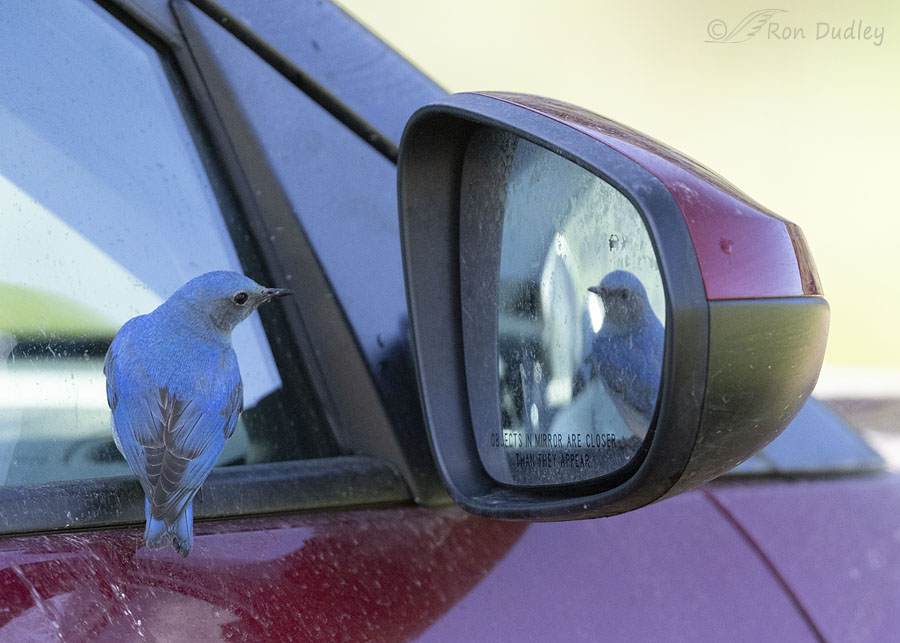
Five days ago in the mountains, as I approached this small car parked in a wide spot along the side of the road, I noticed a male bluebird buzzing around its outside mirror on the passenger side. I figured he was attacking his reflection in the mirror so I tried to maneuver into position so I could take documentary photos. But that side of the car was in deep shade, with bright light in the background, so conditions for photography were atrocious. All I could do was try.
The side of the car was slippery and steep so where he’s perched here was the only spot where he could hold on and see himself in the mirror. From here he repeatedly launched…
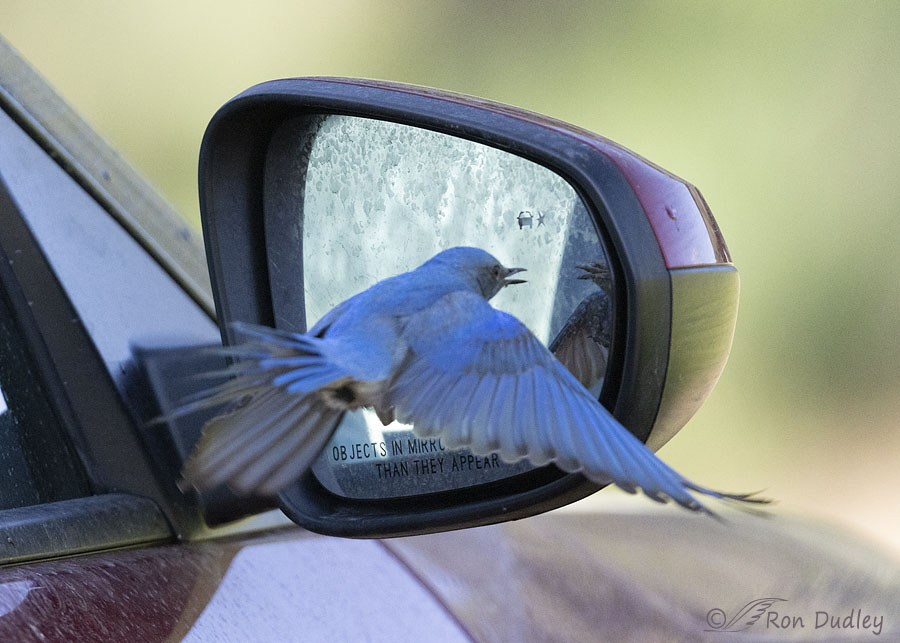
full blown attacks on his own reflection, which of course he thought was another rival bluebird.
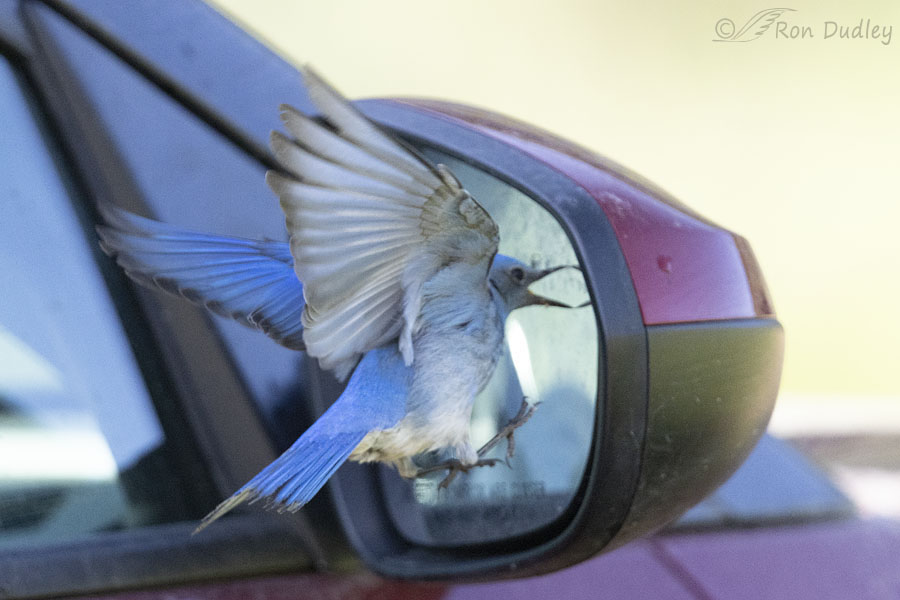
They weren’t bluff attacks. I could hear the clicking sounds produced when his beak and claws…
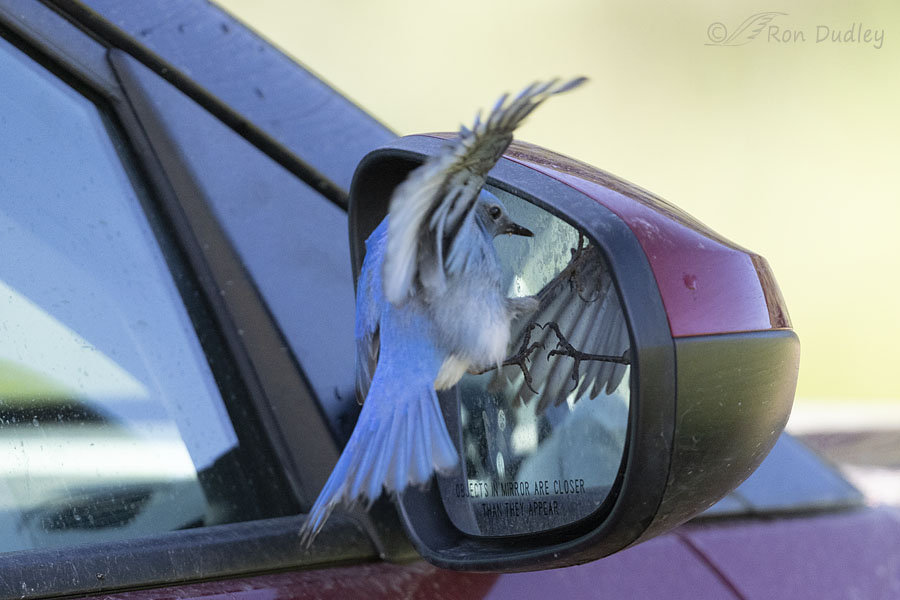
impacted the mirror.
I took lots of photos of him before eventually driving down the road to look for other birds.
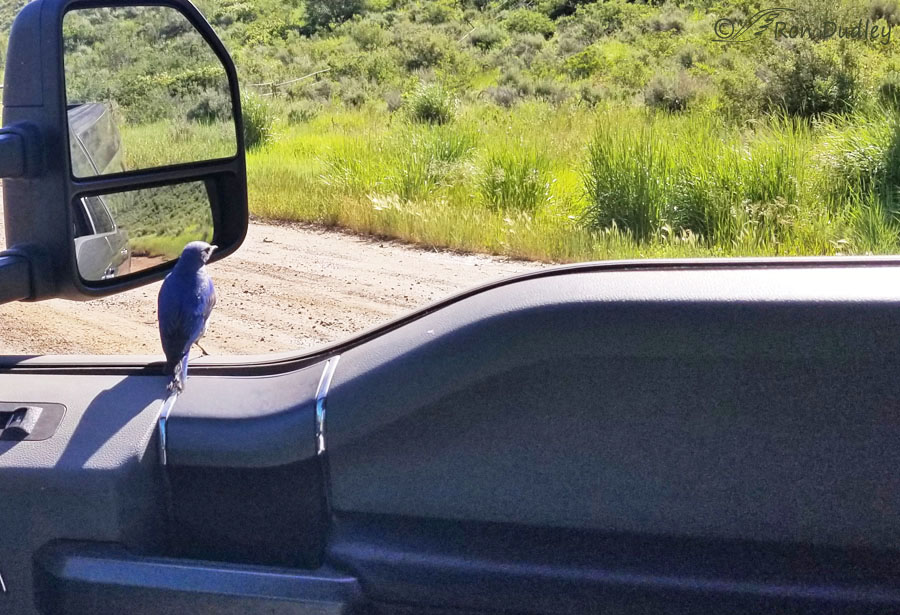
Much later in the morning, when I came back to the same spot, the little car was gone but it took him no time at all to find my own passenger side mirror and his reflection in it.
I rolled my window down to give him a more secure place to perch and he was absolutely fearless, with me only about 4′ away in the driver’s seat (this is a cell phone photo). He alternately landed on my window ledge, on top of my mirror and even on my antenna but he spent most of his time perched here before repeatedly attacking his imaginary rival in the mirror.
At this point I tried to take a video of him attacking my mirror with my cell phone. And I thought I did but when I got home there was no video on my phone. Apparently, when I pushed the video button it didn’t “take”. Dammit!
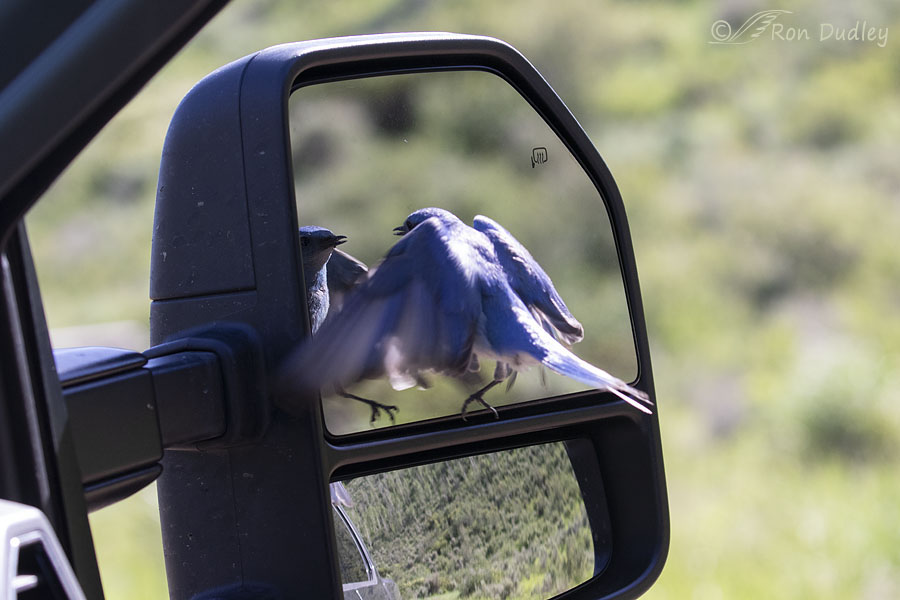
And I couldn’t get decent photos of him with my smaller zoom lens while sitting in the driver’s seat because I was too close and the contrasty light was simply awful so I…
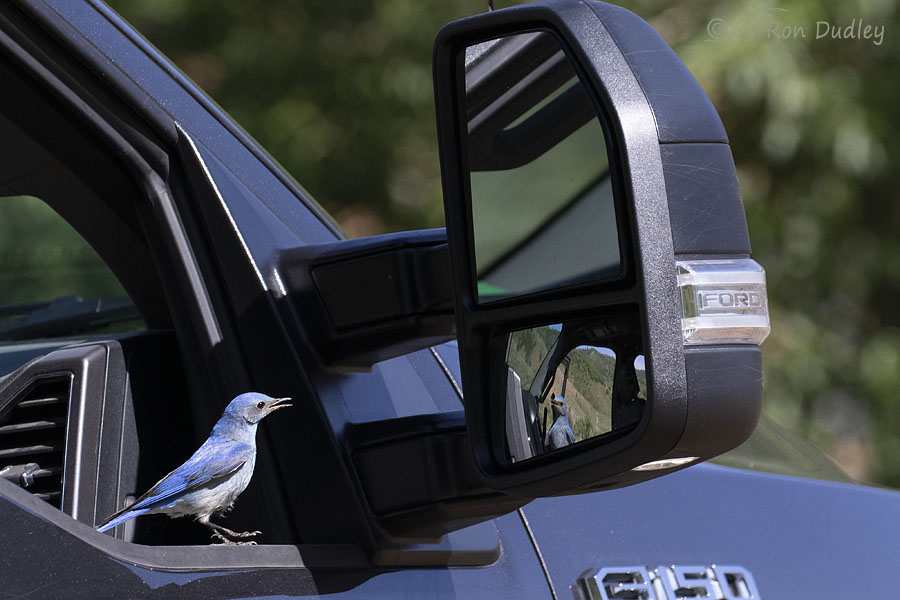
got out of my pickup, walked behind and around it, and took photos from there. While perched on my window ledge he could only see himself in my smaller curved mirror at bottom.
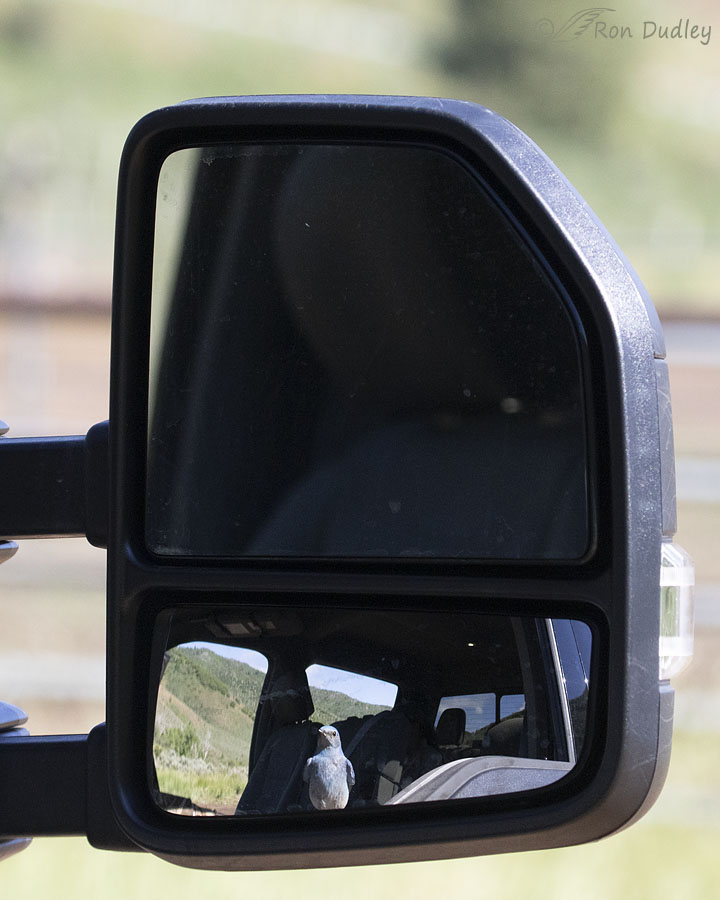
This is probably about what he was seeing from my window ledge.
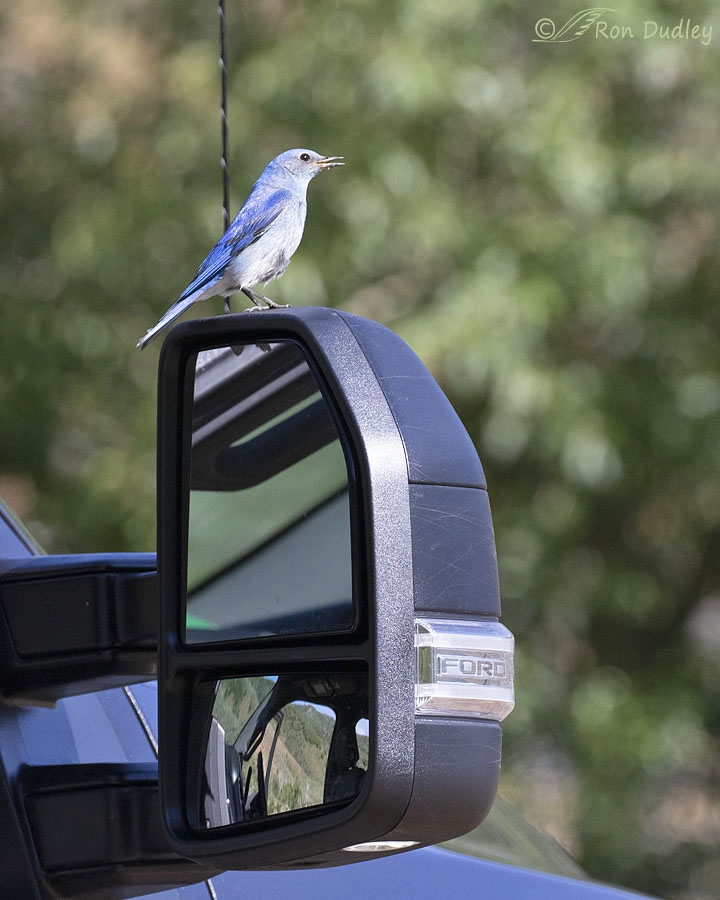
He repeatedly perched on top of the mirror, on top of the upper mirror support and on top of my antenna.
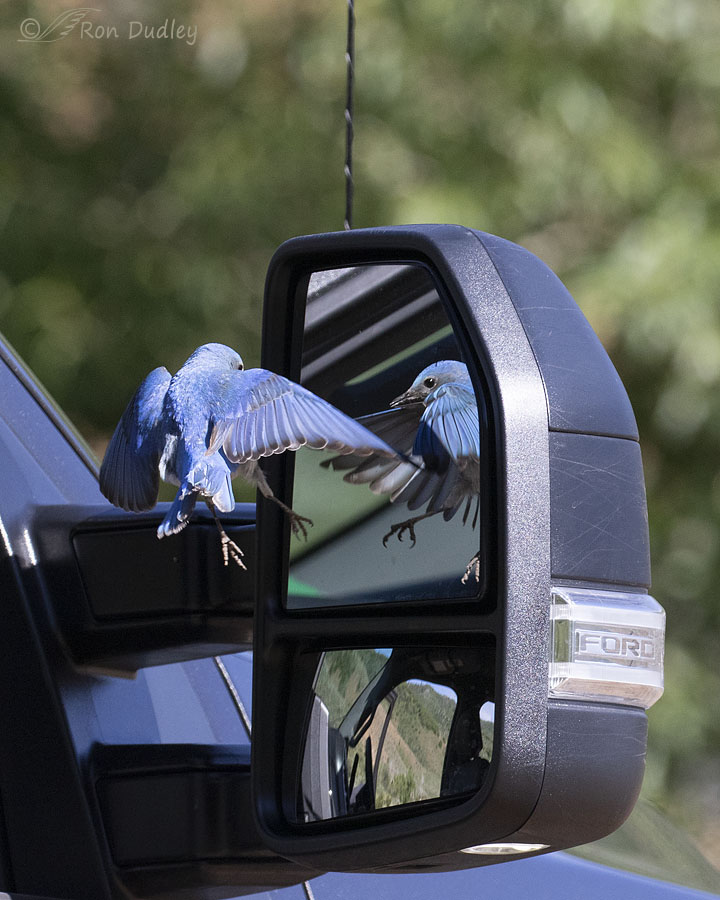
But it was his reflection in the larger upper mirror that really pissed him off.
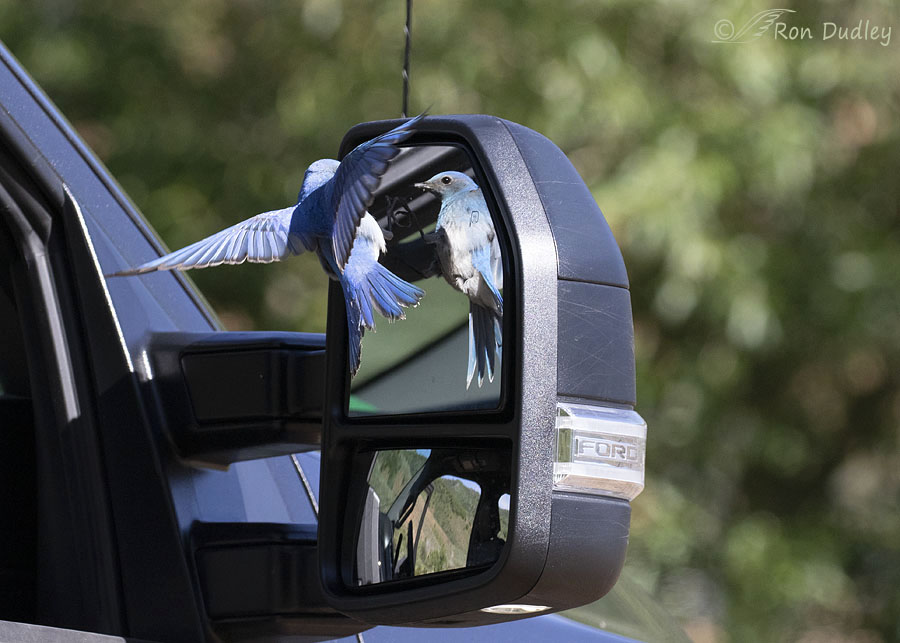
I have a lot of photos like this one but I won’t bore my readers with any more of them.
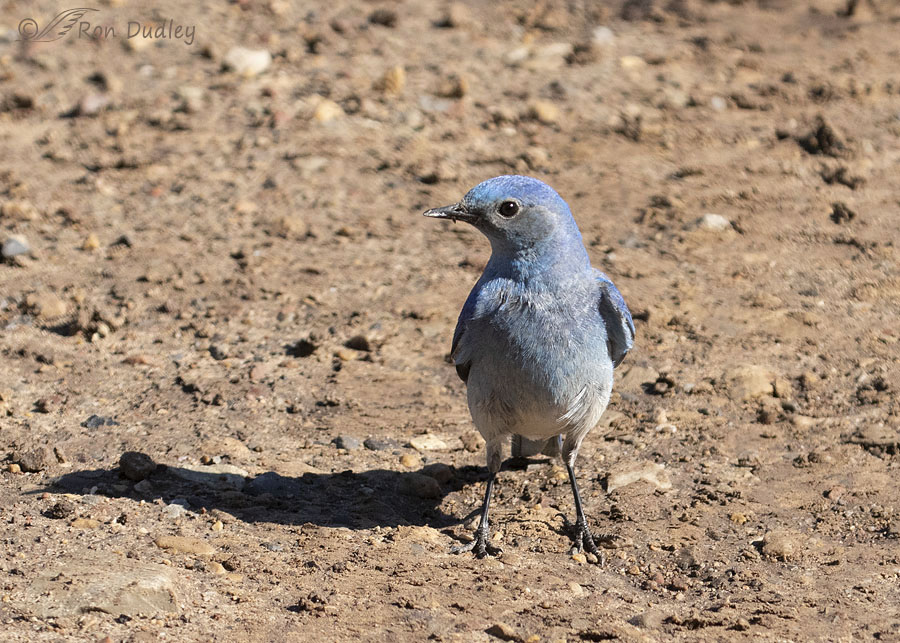
When I walked back around the rear of my pickup to get inside he even challenged me, on the ground right in front of me, so at this point I decided it was time to leave the area, taking my mirrors with me of course, because I didn’t want to be responsible for him wasting any more energy. Especially during nesting season. But I don’t think me leaving made much difference. Cars are parked here often during the day and I suspect he attacked the mirrors of most of them, probably for several days in a row.
If you’re curious about the origins of this highly aggressive behavior, bird authority Dan Gleason made the following comment about it on my post two days ago.
“This behavior is aggressive and not at all like feeding or begging behaviors. This is seen almost exclusively in adult males and only when defending a territory. Usually this only occurs before a mate is obtained or at least before a female has completed her nest and is sitting on eggs. By the time the young have fledged but may still be seeking food from parents, this behavior will have stopped. It is hormonally driven and as nesting season progresses, the testosterone driving this behavior declines and the aggression also declines. Along with this, other hormones increase that initiate brooding in females and males of some species. Males still sing but territories are well established and strong territorial aggression is not as necessary. Boundaries are usually well-respected by other neighbors of the same species.”
Thank you, Dan. We always appreciate your knowledgeable input.
Ron


Great shots! We had a House Finch a few years ago that kept attacking our clerestory windows. I ended up climbing a ladder to tape up a very scary RTHA picture on each window and that helped a little, but definitely freaked out my neighbor the first time she saw it.
I actually get a big kick out of teaser one day, and the rest of the story a few days later. I learn more, having had time & sleep to process what you’re teaching us. And it’s just fun to have the suspense of waiting for the rest of the story. Thank you.
Thanks for telling me that, Cheryl. Much appreciated.
Remarkable behavior and interesting explanation by Dan. Outstanding work on your part getting all these photos. Thanks for posting.
Thank you, Everett.
It’s interesting that just moments after reading this a male Anna’s Hummingbird was face to face with our living room window. However, unlike your bluebird, he showed no aggressive behaviors and I doubt there are strong reflections from that window this time of day. His attention seemed to be focused on a spool of red tape on a table just about a foot beyond him and inside. Not reallly the same as the behavior you show so well but still fun. It’s also been fun watching a pair of Western Bluebirds feeding and making frequent trips to their nest box near our back fence. We live in a typical suburban neighborhood of Eugene, Oregon. This may not seem like a big deal to some, but to my knowledge, no Western Bluebirds have ever nested in a suburban neighborhood here. They belong outside of town, especially around oak woodlands, but not in town. It’s sure been a fun treat to have them. From their behavior I suspect they now have young in the nest.
Enjoy your bluebirds, Dan! Can’t tell you how jealous I am.
Speaking as someone who has negligible amounts a testosterone overload looks exhausting.
A great series but I do hope that he finds a mate and they settle down quickly.
EC, my guess is that he already has a mate but if so, I didn’t see her.
Neat captures. I often get male song sparrows who do this to our cars parked in the driveway. I have to put bags over the mirrors or else the bird spends all day attacking his image an leaving my mirrors a bloody mess.
April, I looked for blood or other damage on this guy but didn’t see any.
Great series Ron! Years ago, before townhomes were built in the old orchard behind us, there was a pile of junk with an old microwave on top. Twice a day a Ring-necked Pheasant would come to fight his reflected opponent. Some kids playing around that area threw a rock through the microwave window and that was the end of our entertainment!
Thank you, Marian.
Ron,
Only you! Only for you would this bird almost come inside your truck and let you photograph him. As soon as I saw the picture of your window down, I, of course, wondered if he would leave you a little donation for the photo session! What fun. I need to go to the canyons and try my luck.
BTW, I was in Idaho with family a couple of weeks ago and found my first ever Western Tanager. Once again, I wouldn’t have a clue what it was without “Feathered Photography.” I looked like a real expert telling my family what it was! We also saw a beautiful mated pair of Sandhill Cranes and new chick in the nest with it’s sibling just cracking out! Yes, I stayed far away.
Best,
Stephen
Stephen, I didn’t notice a “donation” but now that you mention it I’ll have to look more carefully.
I’ve yet to photograph my first tanager this year. It’s overdue.
Such a fun series. Thanks!
Thanks, Kent.
I put the odds to mr mountain bluebird, I think he could take you !
I wouldn’t bet against you, Kelly.
Testosterone has probably made fools of every male at some time in their life, likely more than once. To paraphrase T,R: through a lens of Monty python-ish absurdity:
“The credit belongs to the bird who is actually in the arena, whose face is marred by dust and sweat and blood; who strives valiantly; who errs, who comes short again and again…”
And again and again.
“Testosterone has probably made fools of every male at some time in their life”
Almost certainly, Lyle – including me, when I was a teenager especially.
At least with birds it only lasts for a short time during breeding season. With us it’s year round.
Love it!
One of the problems may be the bluebird’s oft-deplored woeful lack of literacy. The little guy was discombobulated by the message on the window and rage ensued.
Could be…
Not on the window, on the side mirror
What fun even if hard on the bird! Has to be a HUGE expenditure of energy to keep that up for any length of time. The last 2 pictures are REALLY cool IMO.
Has to be a HUGE expenditure of energy to keep that up for any length of time. The last 2 pictures are REALLY cool IMO.
Judy, in spite of his aggressiveness toward his reflection it still surprised me when he challenged me, as documented in that last photo.
The whole world was “it” at that point in time it seems! Of course, I watch very small birds keep after much larger ones particularly at this time of year also – “programed” that way I guess………..
Remarkable.
Thanks, Michael.
Amazingly aggressive behavior ! I can’t help but wonder how much
“vinegar” he’d have left to spend on a a REAL bluebird challenger if
one entered his territory after a long day of his attacking mirrors !
I wondered the same thing, Kris. But when I saw him his vinegar supply seemed to be inexhaustible.
He would probably spend a little less energy on a real rival. True rivals usually don’t stick around as long as these pesky reflections.
Thx for all the chuckles this morning Ron
You’re welcome.